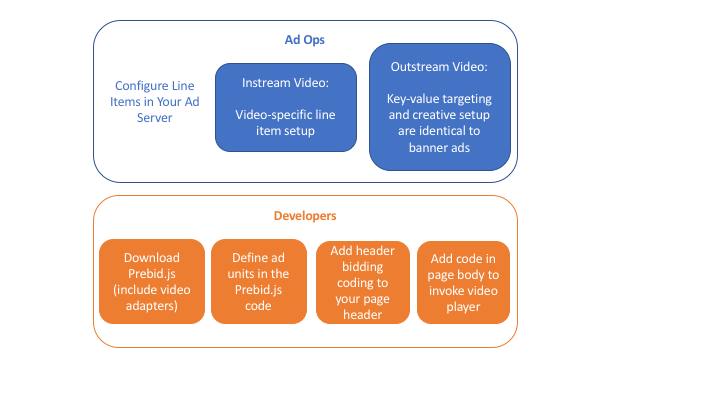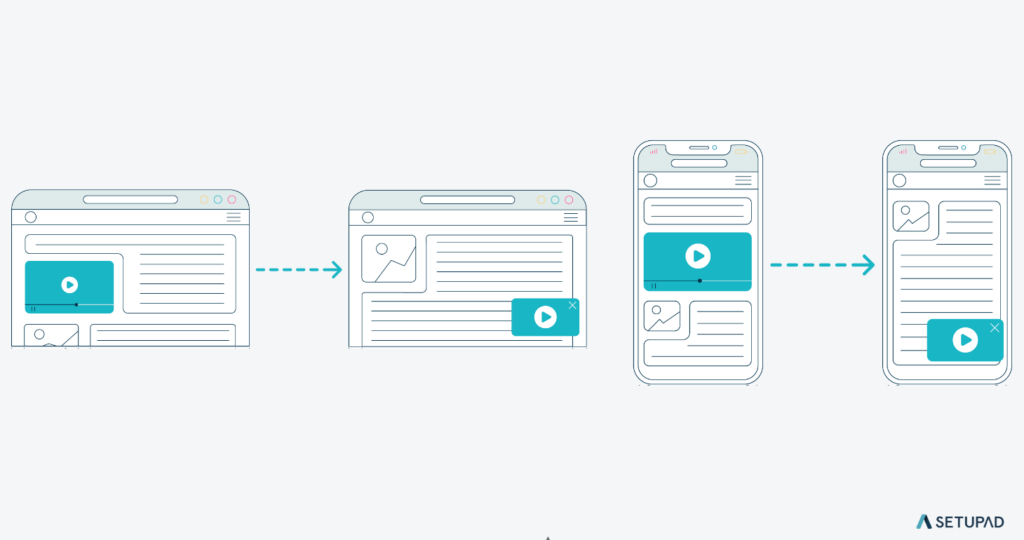What is Video Header Bidding? | A Full Guide for Publishers
Video header bidding has gained approval in the adtech industry due to its rising popularity. Both advertisers and publishers are interested in video ads, given the high levels of engagement and potential for revenue increase.
Before header bidding, the waterfall approach was used to create programmatic videos. But as technology advances, video header bidding is taking over.
This article explains what video header bidding is, how it works, and its benefits.
A Short Recap About Header Bidding
Header bidding among publishers is now the standard method for selling programmatic ads. Publishers previously had to rely on the waterfall, in which demand partners were contacted one at a time until the process was developed.
Header bidding allows demand partners to compete in a single real-time auction. The level of competition is rising, which boosts the revenue from advertising.
Both publishers and advertisers benefit from this.
Publishers will see higher bids and revenue, and advertisers will have better opportunities to place bids on high-quality inventories.
You will have a fair understanding of how video header bidding operates if you’re already familiar with header bidding. There are only a few minor differences.
What is header bidding?
Header bidding enables publishers to offer their ad inventory to multiple ad networks and ad exchanges simultaneously. It’s a programmatic auction in which bid requests are sent in real time to several demand partners to raise the value of ad inventory.
One of the main benefits of header bidding for publishers is greater yield.
As header bidding permits a simultaneous auction from all the bidders, publishers can sell inventory on a per-impression basis.
Header bidding vs real-time bidding
One method of selling ad inventory through real-time bidding (RTB) is header bidding, but it can also include such methods as waterfall, private auction, programmatic guaranteed, etc.
Digital ads can be purchased and sold in RTB through real-time auctions. It’s traditionally related to open auctions.
What is Video Header Bidding?
Video header bidding enables publishers to instantly sell their video ad units to advertisers. Publishers can simultaneously offer their video inventory to multiple demand sources (e.g., DSPs through SSPs and ad exchanges).
Similar to header bidding for display ads, video header bidding can be done on both the server and client-side.
Traditional header bidding and video header bidding have similar concepts, but they are implemented differently. The fundamental difference is a player.
Video players lack header tags because they are often just a piece of JavaScript (JS) on the page. If header bidding is done correctly, the winning bids can be passed into the video player while the bidding takes place in the page’s header parts.
Prebid.js (an open-source header bidding wrapper) makes it possible, but only when the video player loads simultaneously with the page.
Video header bidding benefits
There are 6 benefits of video header bidding:
- Flexibility and diversity. Video header bidding can help publishers diversify their revenue streams by investing in other ad formats than display ads.
- Revenue growth. Increasing publisher’s revenue by diversifying their advertiser base can also help to improve the demand for their inventory.
- Better ad quality. If advertisers want to reach users who prefer video ads they will bid more to reach this group. This will result in ads that are very relevant to the user.
- User experience. Video header bidding made it easier to sell and display ads, improved the page load speed and the overall user experience. The fact that a header bidding wrapper runs an auction while a video player is being loaded ensures that there is no delay in the ad display.
- Maximized revenue: Video header bidding increases ad revenue because video ads tend to have a higher eCPM and click-through rate (CTR) compared to static ads. New SSPs and ad exchanges can be easily added, tested, and removed if they don’t perform well.
- Increased ad fill rate: The more demand partners a publisher has, the higher their ad fill rate is likely to be. The fact that the demand for a video ad often outweighs the available inventory also ensures a high demand for ad fill rate.
Video header bidding disadvantages:
Here are 4 disadvantages of video header bidding:
- Too much data sharing. The user’s data is shared with all demand sources. Header bidding allows all demand sources to see how much programmatic video inventory a publisher has. As a result, an advertiser may target the same audience on low-quality sites and still connect with that audience as they would on a premium publisher’s site.
- Transparency. Advertisers are unaware whether the price they pay for inventory is the same amount the publisher receives or if the publisher or a header bidding provider receives a commission.
- Latency. Slow load times are a big problem for video, but this can be amplified by making multiple ad calls within the page’s header or the player itself. Page latency can be reduced, for example, by sending out ad calls straight away instead of waiting for the user to click on the play button or by employing server-side header bidding.
- There aren’t many videos available. Video inventory is somewhat limited compared to display. However, as more publishers switch to instream and outstream video ads, which provide higher CPMs than display ads, this might resolve the issue in the future.
How Does Video Header Bidding Work?
The core goal of header bidding is to allow multiple demand sources to simultaneously bid on the same ad inventory.
In video header bidding, the player sends an ad request whenever a user views the video.
Multiple ad networks, ad exchanges, and SSPs simultaneously place their bids for that impression.
The demand source that places the highest bid wins the auction, and they can serve a video ad on the publisher’s site.
Both client-side and server-side auctions are available in video header bidding. The process is almost the same in both situations, but the main difference is the auction’s location.
How does client-side video header bidding work?
Here are 7 steps that show how client-side video header bidding works:
- As soon as the video player loads, the JS code in the video player sends bid requests to the selected SSPs and ad exchanges
- The SSPs and ad exchanges send the ad request to the demand sources (e.g., DSPs and ad networks), and each of them place their bids on the available inventory.
- The bids are sent to the header bidding wrapper through the SSPs/ad exchanges.
- Each bid is evaluated as long as they respond within the given timeout period set by the publisher.
- The header bidding wrapper sends the highest bid to the publisher’s ad server.
- The publisher’s ad server compares the winning bid against the bids from direct campaigns, private marketplace deals, etc.
- The highest bidder is selected, and the ad video file is sent to the video player and displayed to the user.
How does server-side video header bidding work?
Here are 7 steps that show how server-side video header bidding works:
- The video player loads, and the header bidding wrapper sends an ad request to the server.
- The ad server sends the ad request to multiple SSPs and ad exchanges, which forward the ad request to multiple demand sources (e.g., DSPs, ad networks).
- The SSPs and ad exchanges return the highest bid along with the ad creative to the ad server within the given timeout period.
- The ad server sends the winning bid to the header bidding wrapper.
- The wrapper sends the bid to the publisher’s ad server.
- The publisher’s ad server compares the winning bid with the bids from direct campaigns, private marketplace deals, etc.
- The highest bidder is selected, and the video ad creative is sent to the video player and displayed to the user.
Client-side vs server-side video header bidding
The auction process is very similar for server-side and client-side video header bidding.
The only difference in server-side video header bidding is that the header bidding wrapper is not where the video inventory auction is held. It’s on a separate ad server.
The publisher’s ad server compares the highest bid to other demand sources before deciding, just like client-side video header bidding. The winning ad is then displayed to the user.
It’s a bit more complicated when employing a client-side wrapper for video because JS is required on the page to connect the wrapper to the video player, which can also cause latency issues.
The adoption of different video players adds complication to this situation.
To insert the ad in the proper location, the integration code must call the player’s APIs if mid-roll or post-roll ads are being served.
A server-side wrapper that executes behind a VAST tag is an alternative to client-side integration. Implementation is more accessible with a server-side wrapper running behind a VAST tag.
Understanding the Prebid Server
While many might be familiar with client-side header bidding, where bids are managed within a user’s browser, another key player in the mix is the Prebid Server.
A server-side header bidding solution, the Prebid Server handles bid requests outside the browser directly on a server. The main advantage of this approach is its speed and efficiency. By shifting the auction dynamics server-side it significantly reduces the browser’s workload, which can mitigate latency issues.
Additionally, with the Prebid Server, there’s a reduction in the number of ad calls made by the browser, ensuring that the web page and its content load seamlessly. But it’s essential to note that server-side solutions also come with challenges, such as less visibility into auctions for publishers.
Nonetheless, for many publishers and advertisers, combining client-side and server-side bidding strategies can maximize revenue opportunities while ensuring a smooth user experience.
How does video header bidding work with prebid.js?
Prebid.js enables tools for video header bidding demand to compete with video demand from your ad server.
The implementation of video header bidding for ad ops and developers is simplified in the illustration below.

Source: Prebid
Long-form, instream, and outstream video units can integrate prebid video demand.
- Instream video ads
Instream video ads play simultaneously with the video content already present on your page.
The ads may run before, during, or after a piece of video content. The publisher must offer their own video player for rendering the ads.

Source: Setupad
- Outstream video ads
Outstream video ads play independently of any other video material.
On pages without video content, outstream video ad units are frequently utilized to build video inventory.
An associated outstream video renderer, which typically consumes configuration options regulating user experience, displays the outstream video ad.
For example, the outstream video player may be set up to expand inside a text body on the page when it is visible and to collapse when the video is complete.

- Long-form video ads
Long-form video content always has a beginning, middle, and end to the story.
Ads appear in ad pods, which are collections of individual ads that appear at the start, finish, or throughout the video content.
Header bidding wrapper types:
The header bidding wrapper is the JS code on the publisher’s website that sends bid requests to demand partners.
The wrapper calls each bidder, waits for all bids or the end of the timeout, and then chooses the highest bid.
The publisher’s ad server receives the highest bid, including targeting keys with the bid information.
Those targeting keys on the ad server produce a wrapper line item.
Ad servers typically choose line items based on the item’s configured priority and then among line items with the same price priority. The ad creative from the wrapper’s bid will be used if the wrapper line item is chosen.
There are 3 types of header bidding wrappers, that can be used on both client and server-side setup:
- Open source wrappers–have a fully available and adaptable code publishers can implement on their websites.
An open-source wrapper solution allows publishers to maintain independence and manage their ads. Prebid.js is the most popular open-source wrapper. It’s free, making it a popular choice for publishers starting with header bidding.
- Proprietary wrappers–built by ad tech companies from scratch by using their own code.
The top SSPs and ad exchanges typically provide a proprietary wrapper solution.
- Managed wrappers–offer initial installation support and continuing maintenance regardless of the code used, which lessens the burden on publishers’ developers.
The wrapper is frequently constructed on top of prebid, which is the finest feature of managed solutions. The benefits include total transparency and additional advantages based on the supplier.
How to Set Up Video Header Bidding?
One of the things that separates video header bidding from traditional header bidding is the implementation process. The process of how the wrapper transmits the bid to the ad server and serves the ad is straightforward regarding display.
Nonetheless, you can always choose to set up video header bidding yourself if you have prior experience in the ad tech industry and particular criteria for demand partners, pricing floors, etc.
In this case, you need to create your header bidding wrapper, combine it with an ad server, and perform the essential testing.
The benefit of this approach is that you receive everything you require for free.
The drawback is that most publishers can’t use it because it requires extensive coding knowledge.
Here are the 5 main steps of video header bidding implementation:
- Set up the video ad units. The first step is creating the video ad units, including all the parameters related to the video ad and player. For example, the size of the video player, the minimum and maximum length of the video ad, will the ad is skippable, whether or not it is VPAID inventory, etc.
- Set up the line items and ad creatives In your video ad server. Afterward, you must configure your video ad server’s line items and ad creatives to the proper sizes.
- Add video ad units to your header bidding wrapper. The next step is to include the video ad units in your website’s header.
- Set suitable timeout for your demand partners. Ensure you have specified the timeout for your demand partners when inserting the ad units to reduce latency. You can also configure your header code to keep track of video demand from each impression. After this step, you can send the requests to the configured demand partners.
- Integrate the header bidding wrapper and the video player to pass the winning bid creative from the auction to the player. Once you’ve finished setting up ad units in the ad server and page header, you need to integrate the wrapper and video player. It enables the wrapper to send the video player’s winning bid response. The most significant difficulty of implementing the entire video header bidding process is connecting your bidding wrapper and the video player, which requires using JS code.
Conclusion
Due to the wide variety of video players that publishers use, setting up video header bidding is a complicated process.
The wrapper should be responsible for bringing everything together while serving video ads, including the publisher’s ad server, the VAST cache server, the video player integration, passing the winning bid, and maintaining statistical data.
Although this method may appear a little intimidating to beginners, some partners can make the setup and bidding process easier with their managed solutions.
Whatsoever, if you’re a publisher with a sizable content library and a respectable amount of website traffic, you’re losing out on a lot of potential ad revenue if you haven’t yet integrated video header bidding into your monetization strategy.


